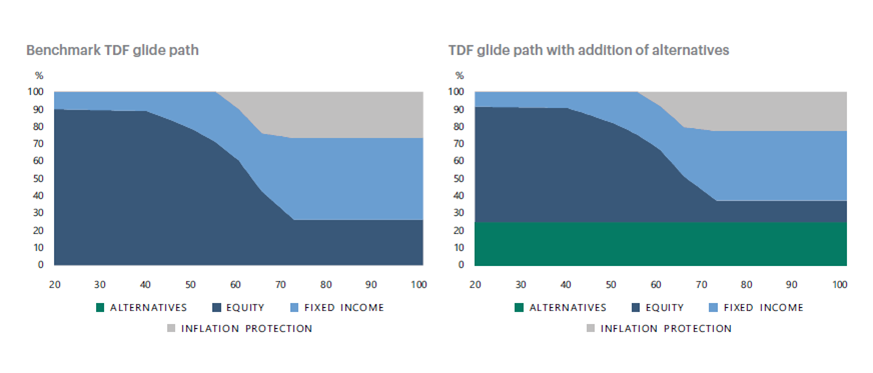As the US retirement landscape continues to evolve, the ongoing shift from defined benefit (DB) pensions to defined contribution (DC) plans continues to expose the critical gap in both retirement savings and strategy. The traditional portfolios powering today’s DC plans—typically centered around publicly traded equities and bonds—are showing signs of strain, especially in a world defined by heightened market volatility, concentration, compressed returns and growing longevity risk.
These challenges present a prime opportunity for DC portfolios to evolve. As illustrated here, the diversification of DC portfolios through private market integration can potentially offer better returns and less volatility for retirees.
The Power of Portfolio Innovation
As a benchmark, we took a traditional target date fund (TDF) portfolio that invests exclusively in publicly traded securities across asset classes (rebalanced and simulated through age 100), and we compared a new alternative: a portfolio with an allocation to private markets.
To do this, we made periodic adjustments to asset-class allocations in the glidepath of the portfolio. In brief, we rebalanced the portfolio to match the glidepaths on an annual basis.1 Glidepaths assume the establishment of the portfolios at age 20 and carry them through age 100.1 The portfolio starts with an initial contribution of $620 at age 20, which is then supplemented by additional annual inflation-adjusted contributions of $620 growing at 3% until age 65, when retirement starts. During the decumulation phase, we consider withdrawal rates of both 4% and 6% a year.
For the private markets, we add four alternative asset classes—private equity, private debt, private real estate and private infrastructure—to our benchmark TDF.1 The analysis assumes a fixed allocation of 25% of the portfolio to the alternatives bucket throughout the life of the portfolio. The allocations within the alts bucket, however, change over time, mimicking the portfolio’s exposure to public markets.
Adding alternatives to a TDF

Source: Apollo Analysts.
For illustrative purposes only and are not actual results. If any assumptions used do not prove to be true, results may vary substantially.
Superior Outcomes Across Key Retirement Metrics
Apollo’s analysis models a scenario where a TDF allocates 25% of its portfolio to alternatives—including private equity, private debt, infrastructure, and real estate—while reducing its public equity exposure. Here are the results:
- Net annual return increases from 6.52% to 7.54%
- Estimated retirement balance grows by 33%, from $261,802 to $347,377
- Legacy value at age 90 rises by 82%, from $415,584 to $757,796
- Probability of portfolio depletion ("ruin") drops from 1.69% to 0.47%
These improvements are achieved with no increase in volatility and only a modest rise in expense ratio, showcasing the potential benefit of diversifying beyond public markets.
Reimagining the Future of Defined Contribution Plans
The findings support a broader thesis: DC portfolios should increasingly mirror their DB predecessors, leveraging private markets to drive higher risk-adjusted returns and address diversification and longevity.
With regulatory advancements and the emergence of accessible semi-liquid investment vehicles, implementation barriers are falling fast. What once seemed complex or impractical is now within reach through modern, professionally managed solutions.
In a world where the responsibility of retirement increasingly lies with individuals, offering them professionally managed, institutional-grade tools is not just smart. It’s essential.
- Apollo Analysts, June 2025.
Tags
The information contained in this commentary is provided for educational and informational purposes only and should not be construed as financial or investment advice, nor should any information in this commentary be relied on when making an investment decision.
Investing involves risk including loss of principal. Alternative investments often are speculative, typically have higher fees than traditional investments, often include a high degree of risk and are appropriate only for eligible long-term investors who are willing to forgo liquidity and put capital at risk for an indefinite period of time. They may be highly illiquid and can engage in leverage and other speculative practices that may increase volatility and risk of loss.
Diversification does not ensure profit or protect against loss.
Opinions expressed herein reflect the current opinions of Apollo Analysts as of the date appearing in this commentary only. This commentary is not complete and the information contained herein may change at any time without notice. Apollo has not made any representation or warranty, expressed or implied, with respect to fairness, correctness, accuracy, reasonableness, or completeness of any of the information contained herein (including but not limited to information obtained from third parties unrelated to Apollo), and expressly disclaims any responsibility or liability therefore.
This commentary does not constitute an offer of any service or product of Apollo. It is not an invitation by or on behalf of Apollo to any person to buy or sell any security or to adopt any investment strategy, and shall not form the basis of, nor may it accompany nor form part of, any right or contract to buy or sell any security or to adopt any investment strategy. Nothing herein should be taken as investment advice or a recommendation to enter into any transaction.
Past performance is not necessarily indicative of future results.
Please click here for additional important disclosure information.



